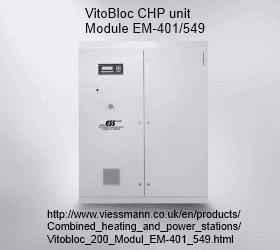Look Mr Abbott-No Carbon Tax For My Business

|
| VitoBloc CHP unit Module EM-401/549 |

|
It’s great to be here at Aaron’s Linen Service. I want to thank Vic Stolar and his family for making Bert van Manen and myself so welcome. This is one of the thousands and thousands of businesses right around Australia that is nervously waiting for the carbon tax. Vic’s business has got a power, gas and electricity, bill of about $1.2 million every year that’s going to go up and up and up - $120,000 just for starters - and that makes it so much harder to employ people. There are about 120 people working here in this factory and laundry. |
| Liberal Chicken Little Tony Abbott's fear campaign |
Estimate of energy requirement: $120,000 carbon tax for CO2 emissions priced at $23 per tonne implies emissions of about 5,200 tonnes per year.
Allowing about 800 kilograms of CO2 per megawatt-hour implies energy use of about 6,500 megawatt-hours per year.
This is equal to continuous energy use of 750 kilowatt-hours every hour, 24 hours per day, 7 day per week, 365 days per year. Note that some energy is required as electricity and some as heat.
ADVERTISEMENT
Using this figure of 750 kilowatt-hours every hour as an indicative guide for in-house power generation, a VitoBloc CHP unit Module EM-401/549 is about the right size.
By generating power in-house the high-cost Australian electricity distribution grid is avoided. This represents the greatest saving. This saving is perhaps 25-40 percent of the $1.2 million annual power bill.
As an added bonus, total emissions will be less than 25,000 tonnes of carbon dioxide per year. As a result NO carbon tax will be payable. This is a further saving of 100 percent of the estimated carbon tax of $120,000 per year.
Coopers Brewery's Cogeneration Plant
Most of Coopers Brewery’s electricity and steam requirements are drawn from a 4.4 megawatt (MW) natural gas-powered co-generation plant located on site. (Source: Generating Smarter Energy)| The co-generation plant was built in 2002 in partnership with AGL, as part of a 20-year energy supply agreement. A dedicated 4 km natural gas supply line was also negotiated to supply the necessary gas at high pressure, which is burned in a gas turbine to drive the electrical generator. Waste heat from the gas turbine is harnessed to produce steam used in the brewing process. |
Eighty percent of the fossil fuel energy is converted in the co-generation plant into useful energy of power and steam, approximately 2.5 times greater than a conventional coal-fired power station. This has reduced carbon dioxide emissions by up to 15,000 tonnes per annum compared with using grid electricity and conventional gas-fired boilers.
While the co-generation plant produces 24,000 megawatt hours (MWh) of power per year, the brewery itself only uses about 6,500 MWh. The excess power is fed into the South Australian power grid through a high voltage underground power line.
The plant also generates 50,000 tonnes of steam a year, used for heating in the brewing, evaporation and packaging processes. Steam was previously generated at the brewery by standalone gas fired boilers.
An absorption chiller unit has also been installed, which uses surplus steam from the cogeneration plant to produce chilled water for brewing.
Look Mr Abbott-No Carbon Tax For My Home -
Ceramic Fuel Cell's BlueGen
Ceramic Fuel Cells developed BlueGen, a biomethane or natural gas driven generator that small enterprises and households can buy and install that silently generates electricity and hot water at a cost way under the majors. You can imagine how much opposition the incumbents have created when faced with this threat. (Source: Lights on for an energy minnow)

|
| Ceramic Fuel Cell’s BlueGen micro combined heat and power (mCHP) unit Garage installation |
It’s not often that a small Australian company gets to look at an enormous market and find it is the leading global player. Overseas institutions, a few individuals and Australian self-managed funds are its main shareholders. No large Australian institution is involved.
US based giant – the $4 billion capitalised Jabil – believes this is a product that, one way or another, is going to be manufactured on a massive global scale.
Update Tuesday, June 19, 2012
The BlueGen product uses ceramic fuel cells to turn natural gas into electricity and heat for hot water.
The units generate electricity with the highest electrical efficiency of any small scale generating technology in the world, reducing energy bills and cutting carbon emissions. (Source: BlueGen units to be used in Virtual Power Plant Project in The Netherlands)

0 comments:
Post a Comment